Information
Generously Supplied by
Arabian Horse Society of Australia |
| Edited by
Melissa Dey |
Arabian horses have been bred along pure
lines in the Arabian Peninsula and North Africa for at least 1,000
years. The Arabs were not the first to domesticate the horse, but they
were the first to carry out selective and planned breeding. The
Arabian horse today shows features which can be directly related to its
early development.
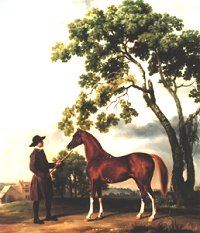 |
Horses first appeared in Egyptian art
around 1600 B.C. They were shown as having arched necks
and prancing in a spirited way. The Egyptians worshipped them, and
treated them with great devotion. Special horses were even mummified.
From these early times the grace and beauty of The Arabian came to be
valued. All over the Arab World horses became status symbols for
the rich and powerful. They were very scarce due to all the obvious
problems of raising horses in the desert, but Royal and wealthy people
took breeding seriously all the same.
(left) Lord
Grosvenor's Arabian with a Groom by George Stubbs |
|
Mahomet used horses to great effect in
his Holy Wars. They proved faster and more manoeuvrable than camels.
It was Mahomet who directed that horses should be bred by the faithful
(Moslems) so that they would be better prepared to gallop out and spread
the Faith of Islam. The Order from the Prophet, enshrined in the Koran
meant that horse breeding began to spread among the Bedouin and the true
Arabian breed began.
|
|
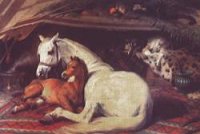
Arabs Tent by
Sir Edwin Landseer
|
The Bedouin had to raise their horses
under the most difficult conditions. They were poor but driven on by
religious belief. They had no crops to speak of and rather unreliable
water supplies. Horses were raised on Barley, Dates and Camel's
Milk. Under these awkward conditions the Bedouin took care to breed only
the best possible horses. The Bedouin's horses were part of their
families: they ate their food and lived in their tents. Arabian horses
are still animals which enjoy and seek human company. |
The Arabian is also a willing and
obedient servant. The legend goes that an ancient Arabian King taught a
fine group of desert horses selected from far and wide to come to him at
the blow of a horn. After thus teaching them, he kept the whole group
away from water for two days and two nights until they were frantic with
thirst. He then released them allowing them to go free to water but
before they reached it, he blew his horn. Five mares dutifully returned
to their master, overcoming their desire for water. These mares formed
the five main strains of Arabian breed and were known as Al Khamsa (the
five). They have passed their temperament on to future generations.
|
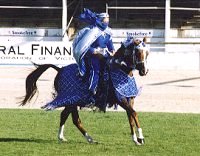
|
The popular Arabian
costume class draws it's influence from the historical. Plus a lot
of colour and finery to add to the spectacle. These classes
are a favourite with spectators, admiring the noble steeds and
their extravagantly dressed riders.
(left) Mrs D. Huggard's Burak
Asab
Summer Royal 2000 |
The Bedouins use of their horses in
desert warfare meant that they had to develop horses with great speed,
stamina and strength. They had to be tough enough to keep going all day
in the heat. Modern Arabians still possess these features and the strong
hooves which they needed to carry on this heavy work without shoes.
Amongst their other prepotent characteristics Arabians have fine coats
and silky manes and tails. Working in the desert would obviously have
been easier without thick matted hair.
Arab legend has it that the Angel Gabriel
took a handful of the South Wind and said to God, "Here is a
handful of the wind". God took this and used it to create the first
Arabian Horse, a bay, blessing it ".. success and happiness are
bound in thy forelock.. and I have endowed thee to fly without
wings". Many other legends and stories surround
the Arabian horse and the Arabs have 1,000 words to relate to horses, 60
of these are to describe swiftness and speed in the horse.
It all goes to show how seriously the
Arabs took their horse breeding. They developed Pure Bred strains, which
became enormously important and valuable beasts. You had to be very
careful to protect your best stock from "rustlers" wanting
good blood lines. Horses belonging to a given strain could not be
bred to other strains and still give pure bred stock. This custom may
have given rise to the modern standard that horses with any other breed
anywhere in their lineage can never be accepted to the purebred
register.
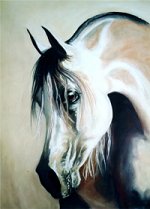 |
The Arabian is a
favourite subject of many equine artists. Bernice Dey provided
us with the lovely head shot for this month's Breed Feature. She
lists the Arabian as her favourite subject.
"The beauty and elegance of these animals inspires me to
try to catch their spirit". She is a favoured artist
amongst Arabian owners who appreciate the way in which she
captures the unique beauty of their horses. |
The Arabs valued their mares most highly.
These were used almost exclusively, in preference to stallions. Many
Bedouins did not even keep stallions, which were considered quite a
nuisance. The Arabs believed that any mare bred to a non pure stallion
could never again produce pure foals: such a mare was contaminated and
had no future as a brood mare.
One of the desirable features of the
Arabian Stallion is a masculine and spirited nature (not
uncontrollable). Stallions, with their high spirits were probably less
easy to manage around tent settlements, where the horses had to be
amongst the people. They were also more difficult to manage in battle.
Mares traditionally have more feminine appearance and manners.
Large studs still exist in Egypt and
other Arab countries. Arabian Racing is still a popular pastime in these
countries. Horses originating here have been used to establish and
improve just about all modern saddle breeds. The Thoroughbred for
example, owes its origin to three Arabian stallions. The Arabian retains
its prepotency and the characteristics which make it a brilliant saddle
horse. It is probably one of the most popular breeds throughout the
World with breeding establishments in just about every country.
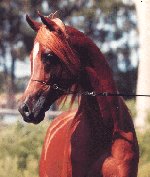 |
Kerry and Richard
Chapman's Australian bred Arabian stallion
Gleniph Royal Sovereign is by
Simeon Sanagor, a stallion exported to the USA. He is out
of Glenallan Messya.
Gleniph Arabians stand a number of purebred Arabian stallions. |
In Australia all Arabians must be
registered with The Arabian Horse Society of Australia. Stallions and
Mares must be blood typed before they can be bred and pure bred foals
can come only from pure bred parents; they cannot be "bred up"
to pure as in many other Societies.
Arabian Breeders and Owners can take
pride in the knowledge that their breed is the oldest and most
influential in the modern World and that the characteristics of their
horses come from centuries of selected breeding. Arabian horses of good breeding are
without parallel in their suitability as Show, Race, Endurance, Working
or simply Pleasure Horses. Many horse breeds show the influence of
the Arabian horse.
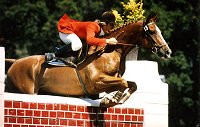 |
Gay
Scott (Anglo-Arab) took his owner Carolyn Earl through the
ranks of pony club and in to the Royal show arena before
commencing his showjumping career. Partnered with Les
Bunning he became the Australian
Showjumper of the Year. Gay Scott was bred at Fenwick
Stud.
By Shafreyn,
Out of Scotch Trust. |
The Arabian's head has a
characteristic dished profile with a prominent eye, large nostrils and
small teacup muzzle. His gracefully arched neck rises out of a long
sloping shoulder and broad chest. A short, strong back and high trail
carriage complete the picture. Arabians
come in most colours, but the most common are grey, chestnut, bay and roan
and an occasional solid black. Although some individuals will vary, most
are between 14.2 and 15.2 hands in height and weigh between 350 and 450
kilograms.
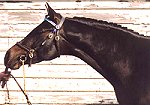 |
Part Bred Arabian
Stallion Copperhead Road (owned by Mrs Dorothy Hockley)
demonstrates all of the desired features of the Arabian
influence in his breeding. |
Arabian Derivatives
Whilst other breed societies condemn
the crossing of their stock with other breeds, The Arabian Horse Society
of Australia has led the way in bringing under it's umbrella all of the possibilities
of Arabian breeding. By allowing Derivative registrations,
the Society has encouraged breeders to make use of Arabian blood to
refine and enhance their breeding programmes.
This classification takes in to
account those horses who have one or more parents of Arabian
ancestry. Each category breed has become a "breed" in
it's own right. For example - An Anglo Arabian can breed Anglo
Arabians. An Arabian Warmblood can breed Arabian Warmbloods
etc.
Talking to Mrs Dorothy
Hockley of Victoria about her successful Arabian Derivative breeding
program, I was interested to learn that she chooses to use Arabian bred
stallions over thoroughbred mares. She feels this combination produces a
specific type of derivative that she is looking to produce. A good
performance horse with trainability and movement, suitable for all
riders, but also a very nice horse to look at. Other breeders may
choose to use Arabian mares with thoroughbred stallions and this
produces a slightly different type of derivative.
Dorothy also made the
interesting comment that a lot of Arabian derivative foals and young
horses may look specifically of arabian type or more thoroughbred type,
but as they mature they become more of the combination of the breeds.
People with an Arabian Derivative breeding program should be aware of
this when they are assessing their youngsters.
The definitions for each category of the
Arabian Derivate section come from information supplied by the Arabian
Horse Society of Australia.
Anglo Arabian
horses
are those derived from registered Arabian horses and registered
Thoroughbred horses. It is widely thought that the breeding must
be half and half, but the proportions of each are not important. Some
of the best European Warmbloods competing in the world have
Anglo-Arabian breeding, demonstrated by the presence of "OX"
in their pedigree. Arabian blood has been used to refine the breeds,
producing the modern sport horse.
|
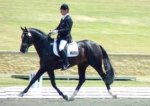
|
Mr Clyde Wunderwald's
Man
About Town (imp)
Black Hannoverian Stallion demonstrating the European policy
of infusing warmblood breeding programmes with Arabian
blood. His sire, Metternich is by Matcho
(Anglo-Arabian), one of the most influential Anglo-Arabians in
performance horse breeding. This talented young stallion offers
Australian the opportunity to breed from outstanding European
bloodlines. |
Arabian
Ponies are those derived from registered
Arabian horses and registered ponies. The ponies must be
registered in a stud book recognised as being for pure bred ponies. Once
again the proportions of each are not important. These ponies show
great versatility and are suited for both children and smaller
adults. Ponies such as Owendale Rory compete at showing, hunt,
attend pony club, jump and do just about everything.
|
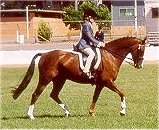
|
Owendale
Rory
Arabian Pony Gelding
By Baughurst William of Orange
Out of Lechlade Honesty |
Arabian
Warmblood Horses are those derived from
registered Arabian horses and registered Warmblood horses (including
those with thoroughbred blood). The Arabian Warmblood cross produces a
true modern sport horse that excels in all equestrian pursuits.
In Australia we have separate registration within the Arabian Society for
horses of this breeding, but in Europe it is very common for Arabian blood
to be introduced to warmblood breeds to add refinement and elegance.
|
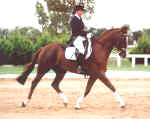
|
Mrs Berni Saunders'
Hollybrook Boston
FEI Dressage Horse
Arabian Warmblood Gelding
By Kaliber (imp) Trakehner stallion
Out of Karen's Image - Anglo
Arab mare. |
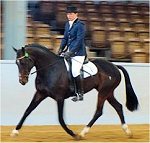 |
Ms Andrea Williams Ashbrook
Park Meccano. Arabian Warmblood stallion by Richmeed
Medallion out of Anglo Arabian mare Deveron Antoinette. This
stallion provides breeders with access to the very best of
European bloodines and Australian Arabian influence also. |
Arabian
Riding Ponies are those derived from
registered Arabian horses and registered Section A Riding Ponies, or registered ponies approved for the
purpose
of breeding Section A Riding Ponies (including those with thoroughbred blood).
A
Part Bred Arabian Horse shall not have less than 25% Arabian
blood. It can be the
progeny of either a
registered Arabian sire, or a registered Arabian dam or
registered Part Bred Arabian parents.
|
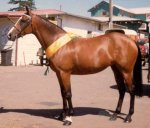
|
Mrs Dorothy Hockley's Good
Vibrations
Part-Bred Arabian Horse. This lovely mare is by the Arabian
stallion Hastar out of a thoroughbred mare. Amongst other awards
that she has won, she was Supreme Champion Arabian Derivative at
the Royal Melbourne Show. |
National Show Horses are
not currently recognised as a separate breed in Australia. They are
derived from 50% Arabian and 50% American Saddlebred and currently
only registered in the USA. In Australia, these horses are registered as
Part Arabians, but enthusiasts are aware of the large difference between a
Part Bred Arabian Horse and a National Show Horse.
|
